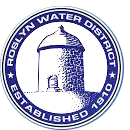
ROSLYN WATER DISTRICT: BUDGET & FINANCES
LEGAL NOTICE
NOTICE IS HEREBY GIVEN that the fiscal affairs of the Roslyn Water District for the period beginning January 1, 2023 and ending December 31, 2023 have been examined by an independent public accountant, and that the report of examination prepared in conjunction with the external audit by the independent public accountant has been filed in the District office at 24 West Shore Road, Roslyn, New York, where it is available as a public record for inspection by all interested persons pursuant to Section 35 of the General Municipal Law. The governing Board of the Roslyn Water District may at its discretion, prepare a written response to the report of the external audit submitted by the independent public accountant and file any such response in the District office as a public record for inspection by all interested parties not later than ninety days from the date of this notice.
DATED JUNE 13, 2024
BOARD OF COMMISSIONERS | ROSLYN WATER DISTRICT
MICHAEL J. KOSINSKI
WILLIAM K. COSTIGAN
SANFORD E. KLEIN
DOWNLOAD ROSLYN WATER DISTRICT BUDGET DOCUMENTS
Behind the Budget Process
Each year, the Roslyn Water District strives to provide our residents with a ‘flat’ budget that holds the line on water rates and the tax levy. The Board of Commissioners want residents to know some of the cost-saving initiatives that help contribute to this success. Click here to view a brief rundown of these initiatives.
Through Operation Save NY (NYSISO,) and in participation with NRG, Inc, the District makes use of its standby generators during periods of peak electric demand, such as summer heat waves. The District receives remuneration for this participation. The net result is helping reduce the peak electric loads on the public utility while generating supplemental income for the District.
The District follows a stringent procurement policy adopted by the Board. It includes working with intermunicipal agreements with the Town of North Hempstead in the purchase of a variety of products and services including fuel and Actuarial services (for compliance with GASB accounting requirements).
The District also makes purchases via the New York State Office of General Services which has negotiated blanket contracts for many items used throughout all levels of State Government.
The District has also implemented an aggressive Capital Improvement Program designed to help assure that current systems continue to function economically, replace antiquated systems with new technologies and manage revenue and expenditure fluctuations due to weather, water usage, etc. This program included the development of the District’s Supervisory Control and Data Acquisition System (SCADA), which provides remote, instantaneous access to all of the District’s facilities.
Additionally, the Automatic Meter Reader project has made billing much more efficient, reduced errors and generally eliminated the need for estimated bills.
These initiatives, plus the cooperation of the District residents in water conservation efforts, the County’s Odd/Even Lawn Watering Ordinance and efforts to adjust irrigation systems to alleviate demand surges during times of peak usage all contribute to the District’s ability to control the budget and tax levy.
It is important to know that the District has not borrowed money for any project since 1998. Maintaining this record will depend greatly on the impact of new regulatory measures, new levels of overall water requirements and the aging of our basic infrastructure.
Factors Affecting the Cost of Water
A number of issues affect the District's overall cost of delivery and basic obligation to deliver an adequate supply of quality water to its residents. In addition, these issues can vary considerably from one year to another and can significantly impact the District.
While a change in water quality drawn from wells can increase or decrease our treatment requirements, this does not significantly affect the overall cost of delivery. With that said, the State’s impending regulations on emerging contaminants (PFOS, PFOA and 1,4-dioxane), capital, operation and maintenance costs for installing and running new treatment systems could impact overall treatment costs and, therefore, the overall budget.
Electric costs have also gone up considerably over the last few years. In order to minimize these increases and monitor their costs, the District has implemented a program whereby an independent expert reviews each energy related bill received by the District. This monitoring program has saved the District considerable expense in obtaining adjustments in costs.
Another Major Variable is the Weather
Consider the summer season's temperature and rainfall... or, lack of it. Depending on whether or not we experience hotter and drier or cooler and wetter weather, water demand will fluctuate significantly. In some cases, the swing can be as much as 30 percent!
In the winter months when pools are drained and lawn irrigation is not as prevalent, the water consumption is, on average, about 50 percent of the summer usage.
However, a difficult winter with spans of below freezing temperatures creates other expenses. The natural heaving and movement of the ground during the freezing and thawing process may cause some water mains to separate, crack or otherwise fail. That’s when you see District staff outside working under difficult conditions to reinstate the water supply.
